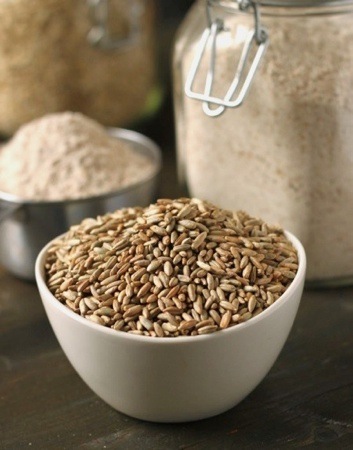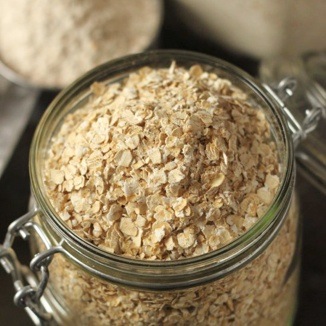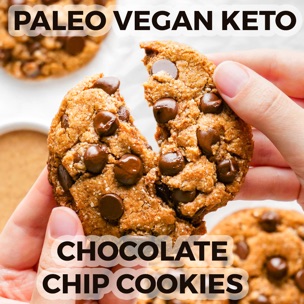Here you’ll find info about the different types of whole grain and gluten-free flour as well as some other not so common ingredients that I use in my baking. And if you live outside of the US, there’s a special section for you!

Almost all of my 100% whole grain recipes are developed in a way that you can’t tell that they’re whole grain. There are a few exceptions but I always make that clear in the post. What I normally use is whole wheat flour, which you should be able to find in any grocery store.
I also like baking with whole spelt, which, to me, tastes less healthy. It has more protein than whole wheat flour and it’s more tolerable for people with wheat sensitivities. It is not gluten-free, though. More on gluten-free flour later.
Whole spelt is sometimes just labeled as spelt, but should then say whole grain on the side of the package. If you can’t find whole spelt in your local supermarket, you can order it on Amazon: Bob’s Red Mill Organic Spelt Flour
Good whole grain flours to start off with
If you have someone in your family who doesn’t like whole grains and you’re just starting to switch, one of these might be a better bet:
- Bob’s Red Mill 100% whole grain ivory wheat flour (aka white whole wheat) – this has all the fiber and nutrition that regular whole wheat flour has, but it tastes milder and is lighter in color. It’s made from naturally occurring “albino” wheat, which is the only reason why it’s lighter. It really does have the same nutritional value! If I were starting off with whole wheat baking, I’d start with this flour.
- Bob’s Red Mill whole wheat pastry flour – this is made from a softer type of wheat that has less protein and less gluten. It’s more finely ground and great for cakes and pastries.
For a primer on whole grain baking, please have a look at my whole grain baking tips on GoodLifeEats.
Gluten-free Flours
There’s a wide variety of gluten-free flours but many of them are either not that easy to find or quite expensive to bake with.
Although I do quite a bit of gluten-free baking, I really only use nut flour like coconut flour, buckwheat, and oat flour (which is just ground up oats). I do this because I don’t usually like the baked goods made with all those hard-to-find flours. I also don’t want to start posting recipes that people don’t actually have ingredients for. If you want some more info on those other types of gluten-free flours, here’s an awesome beginner’s guide to gluten-free flours.
One important thing to note is that gluten-free flours are often not interchangeable! I’ve seen commenters complain on other blogs that their muffins, which called for 1/4 cup of coconut flour, didn’t come out when they subbed in regular flour. It just doesn’t work.
Almond flour
Most of the time in my gluten-free baking, I use almond flour. I don’t even like almonds but I love almond flour! Almond flour is made from blanched almonds that are ground really finely.
Almond meal
Almond meal is usually not as finely ground as almond flour, and at least in my experience, is not blanched. If you make a recipe that calls for flour and you decide to use meal, it might work, but it’ll have itty bitty pieces of almond skin in there. For some things where the texture doesn’t matter, it might be okay, but it’s really best to follow the recipe.
Buckwheat
Buckwheat isn’t related to wheat and actually isn’t even a grain, but a seed that’s finely ground like flour. It’s often referred to as a pseudograin or pseudocereal. Because the full seed is ground and nothing is sifted out, it’s considered a whole grain. It seems as though a lot of people are very confused about buckwheat, so if you still have questions, please read the Whole Grain Council’s post on buckwheat.
Coconut flour
Coconut flour is an interesting flour. It soaks up a ton of liquid so you often see it called for in small amounts. It is possible to bake something with coconut flour as the only flour, but I personally don’t like the texture. I love mixing it with almond flour, though. I often use mostly almond flour plus a tablespoon or two of coconut flour. And it’s worth noting again – you cannot sub coconut flour with other types of flour! Not a clear and straight substitution, anyway.
You can read all about coconut flour at Carolyn’s blog All Day I Dream About Food. Carolyn also has tons of other great gluten-free tips and recipes! You can find coconut flour on Amazon: Bob’s Red Mill Organic Coconut Flour
Oat flour
I just use un-contaminated oats and grind them in the coffee grinder until flour consistency. You can also do this in a food processor. If you don’t want to put in that effort, you can easily get it from Amazon: Bob’s Red Mill Gluten Free Oat Flour – 4 22-ounce bags.

Other ingredients
- Coconut oil
- I normally use refined coconut oil, which doesn’t have any coconut taste. If you don’t mind some coconut flavor, the unrefined kind is great!
- Coconut butter
- Store-bought coconut butter is extremely expensive, so I use homemade coconut butter. It is easy to make, try it for yourself!
- Coconut sugar
- Madhava Organic Coconut Sugar
Finding baking ingredients in Germany (lots of this applies to other countries, too)
When I moved here in 2009, it took me a good while to track down all the baking ingredients I was used to from back home in the US. I hope to save you at least some of that pain!
- Almond flour
- I get Suntree Kalifornische Mandelkerne Gemahlen. They come in little 100 gram bags and cost 1.29 EUR at Kaufland. I’ve seen this brand elsewhere. Make sure you get the blanched almond flour and not the almond meal (which has the skin). Do not buy Mandelmehl (which translates to almond flour). This is a different type of flour and any US recipe you find calling for almond flour refers to blanched ground almonds.
- Baking powder
- American baking powder is double-acting and German (and I believe all baking powder around the world except for North America) is single-acting. This sometimes creates a problem. If you can, try getting some of the American stuff from visitors or whenever you visit the US.
- Baking soda
- Baking soda is called Kaisernatron over here. I’ve found small green bags of it in the baking aisle at normal grocery stores and also in random sections at the drugstores Rossmann and DM. They also sometimes have Arm & Hammer at Asian shops but be sure to shake the box. Most of the time, they’re rocky and I don’t know about you, but I’d rather not buy chunky baking soda. Also, try looking on Amazon for buckets of food-grade baking soda in 1 kg or 5 kg buckets!
- Biscoff Spread
- We’re in Europe! See Speculoospasta down below. :)
- Brown sugar
- It is not Brauner Zucker, Rohrzucker, or anything else you can find in a German supermarket. You can only find it at Asian shops or make your own by mixing 1 cup granulated sugar with 1 tablespoon molasses.
- Chocolate
- Forget the things that are called chocolate chips here. They’re expensive and in my experience, and they don’t taste very good. I get Zartbitter blocks from Netto and the other discounters that are 3.50 or 4.00/kg and they’re great. Once baked, I really can’t tell the difference between those and more expensive chocolate.
- Coconut flour
- Available in Alnatura or any other Bio shop (although maybe only the larger shops?). I get the brand Morgenland. It’s now easily found on Amazon.
- Coconut sugar
- I get mine from Metro and it’s about half the price of what you find in the Bio shops. It’s REALLY expensive there. Like 25 EUR/kg. It’s now also easily found on Amazon.
- Cream cheese
- I get the cheap stuff from the discounters and nobody can tell the difference between that and Philadelphia. It’s .89 EUR/300 grams. The problem is that German (and I believe this applies to all areas outside of North America) cream cheese has a lot of extra whey. For some recipes, like icing, you most definitely have to drain it. I’ll note this in the recipes. Normally, it’s best to get almost double the amount the recipe calls for and drain that in a cheesecloth or a thin kitchen towel that won’t leave behind a bunch of fibers.
- Flour, all-purpose
- All-purpose flour is called Weizenmehl Type 550. Ever wonder why your cookies spread totally flat and are super greasy? The standard flour you find everywhere, Type 405, is like American pastry flour. That’s fine for cakes and brownies, but for cookies, bread and crusts, it becomes an issue. For cookies, I normally do half Type 550 and half Type 405. If I post a recipe with white flour (which is very rarely!) I’ll tell you which German type to use.
- Flour, bread
- Look for Type 812 flour. It’s not easy to find but you can make your own by adding 1 tablespoon of vital wheat gluten to every cup of Type 550 flour. I learned this from No Ordinary Homestead. She has lots of other great expat tips for people living in Germany so go check her out!
- Flour, cake
- Cake flour is called Kuchenmehl. It’s found almost everywhere except at the discounters. I get the Wurzener brand.
- Molasses
- I’ve found molasses at the Reformhaus, but it was really expensive. You could substitute the much cheaper and widely available Zuckerrübensirup.
- Speculoospasta
- The Kaiser’s supermarket near my house now carries Biscoff spread! At the moment, it’s in a display near the fruit section, but I expect that they’ll eventually move it next to the peanut butter and other spreads. It’s 2.99 EUR. And they have crunchy! If you don’t live near a Kaiser’s, you can find it online: Speculoospasta from Amazon. In case they are out at the moment, you can get it here.
- Vanilla
- Make your own! There’s no way around it. I’ll get to this issue later, but for now, you can visit the amazing Healthy Foodie for a tutorial. It’s really easy. Go do that now because i†t’ll take a long time for it to be ready!
- Vital Wheat Gluten
- Look for Weizengluten in bio shops and reform houses. And there’s always Amazon if you want a lot of it!
Now that you have all your ingredients, you can go make these more than yummy New York Times Chocolate Chip Cookies adapted for German ingredients. :)
If you have questions about other ingredients, contact me and I’ll add them!
Disclaimer: Some of the links on this page are affiliate links.



61 comments on “Ingredients” — Add one!
2 comments are awaiting moderation!
Nice! I still haven't found Speculoospasta anywhere so that's a life saver. I've been hoarding our stash from France so thank you so much for the link! And glad that the cream cheese tip will help. You'll see such a huge difference! So frustrating that is took me over a year to figure it out. Thanks again for your comment. :)
You're welcome! Glad that I could help. :-)
Hi Erin,
I thought you might want to know that I found a link that sells Speculoospasta for much less than Amazon (3.99€ for a 400g jar). I ordered two jars and shipping was 4,90€ for both.
Here is the link if you or your readers are interested:
http://www.hollandshop24.de/product_info.php?info=p67_lotus-speculoos-pasta—400g.html
I'm not sure if it is less than what it is at Kaufland, though. I don't have a Kaufland nearby.
BTW, thanks for your tip on draining the cream cheese when making icing! I usually drain the whey from the ricotta but never thought about doing the same thing to cream cheese. :-)
Greetings from south of Hamburg,
Rosa :-)
Steph – I'm happy you've had luck with German baking powder. Sometimes it's okay, like with pancakes, but other times it just doesn't work for me. Happy you now know the answer to the flat cookie problem! :)
Re baking in Germany:
Thanks for the note about flour and cookies – I was so sick of flat and greasy ones, I quit making them.
I've never had any issues with German baking powder and American recipes though.
Carolina – It's frustrating to learn this after making it so many times, isn't it?! I can't tell you how many hours I spent on trying to stiffen up cream cheese frosting. Happy I could help! :)
Thank you for solving my "why doesn´t my cream cheese frosting turn out ok" mystery! I´ll definitely drain it nex time.
Anon – Hi! I get coconut sugar from a Costco like place in small 200 gram bags. I've also found it at organic stores but it's so expensive there. Unfortunately it's not in "normal" grocery stores but I hope you can find some!
We are Americans living in Belgium. Where do you get coconut sugar? I am really interested in trying it. Thanks, Leah
Anon – I hope you like whatever you try! And I get the whole spelt / wheat from Kaufland. I hope you have access to Kaufland. They also have the cheapest nut flours. :)
Thanks so much for posting this! I have been looking for whole wheat pastry flour on base for ever (I am also a Texan living in Germany). So glad to know there is a cheap alternative on the economy!
I look forward to going through all your recipes!
Sarah – I forgot to say that my Kaufland now has Speculoos. It's not the Lotus brand, but a copycat version. It's logo is even similar (at least I remember it being similar).
I think the Asian stuff has a weird smell too. The chunks are annoying as well!
I'm so happy that the draining trick worked! Next time you do it, you can just wring out the whey. It only takes a minute or two. Thanks for letting me know it worked. :)
I hope you find the brown sugar. I've used that Thai stuff in a pinch and was frustrated by the texture – plus something smelled horrid about it. Like B.O. horrid. My husband used it and had no issues with it, so it might just be me.
By the way, I finally had occasion to make a cheesecake again and I drained the cream cheese for a good 24 hours. I had 1050 g of cheese when I started draining and ended up with 750 g afterwards, so it lost a good amount of whey. Then I used my normal cheesecake recipe and the texture was PERFECT. Dense and creamy, but with a good crumb. Thanks so much for the suggestion!
Sarah – Thanks for the tip! I haven't seen that brand at the Asian markets. I've used the Asian (I think Thai?) brand they have and it's okay. I have seen Tate & Lyle at Metro and I wasn't sure if it was really the moist kind. I'll have to take another look. Thanks again. :)
I'm able to find moist light brown sugar at the Asian market. The brand is Tate & Lyle from the U.K. and it works like a champ.
Kristi – Yeah, they call something "brauner Zucker" which directly translates to brown sugar, but it's most definitely raw cane sugar. Very frustrating! And molasses is so expensive here. So I guess it's a good thing I'm trying to bake with honey most of the time. :)
My biggest problem when I lived there was I COUDLNT FIND BROWN SUGAR! Nice tip about making it yourself. I bought some in a market and it was NOT American brown sugar, more like raw cane sugar or something haha.
I hope draining the cream cheese helps! If it doesn't, I really have no idea what it could be. I've been happy with my results here, but I like them really creamy and smooth. Good luck! :)
Nope, they definitely don't have Biscoff here – I checked. Yet another great reason to go to Belgium.
And thanks for the guidance on cream cheese. I can get a fairly rich cheesecake, but I'm having trouble getting it to have that cake-like crumb of U.S. style.
Hi Sarah!
I don't normally drain it when making cheesecake, but it would definitely make a richer and more delicious cheesecake. It's hard to say for how long. What I do is let it sit for maybe 20 minutes, and then start wringing it out until it's like American cream cheese. The last time I made something calling for 400 grams of cream cheese, I used about 700 grams to get the 400 grams I needed.
It makes a huge difference if you ever make cream cheese frosting. If you use the German stuff the way it is, it'll be soupy.
I've seen Speculoos cookies at Metro in Berlin, but the spread is more difficult to find. It's everywhere in Belgium, and I know they have it in the Netherlands and in France. I found
this homemade Biscoff spread recipe for you if you want to try. I haven't made it myself, so I don't know how it'd turn out in a pie, but it does look good. :)
Hello Texanerin!
I'm an American living in Germany, too. Thanks for this ingredient clarification page! I always suspected that there was additional whey in the cream cheese, but I use cream cheese so infrequently that I never planned to drain it. This is probably the solution to disappointing cheesecake. How long do drain it for?
I got here due to the Biscoff pie, as I'm a sucker for Spekalatius (I'm in Bayern). I've never seen Biscoff anything down here before though. What region are you located in? Maybe we don't have it here.